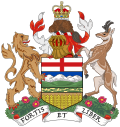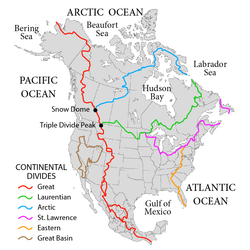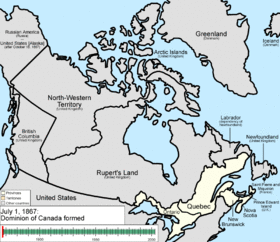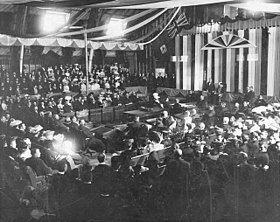Timeline of Alberta history
 From Wikipedia - Reading time: 14 min
From Wikipedia - Reading time: 14 min
| This article is part of a series on |
| Alberta |
|---|
 |
| Topics |
| History |
| Politics |
| Timeline of Alberta history |
Below is a brief timeline covering the history of the province of Alberta and its history pre-1905.
Pre-history
[edit]| Date | Event | Reference |
|---|---|---|
| c. 8000 BC | Head-Smashed-in-Buffalo-Jump is first used, archaeology indicates. | [1] |
Pre-Confederation
[edit]
| Date | Event | Reference |
|---|---|---|
| May 2, 1670 | King Charles II of England grants the Hudson's Bay Company (HBC) a royal charter for "the sole Trade and Commerce of all those Seas, Streights, Bays, Rivers, Lakes, Creeks, and Sounds, in whatsoever Latitude they shall be, that lie within the entrance of the Streights commonly called Hudson's Streights... which are not now actually possessed by any of our Subjects, or by the Subjects of any other Christian Prince or State... and that the said Land be from henceforth... called Rupert's Land". Part of Rupert's Land covered part of today's Alberta. (The Milk river valley in the extreme south of the province and the north half of the province were not part of the Hudsons Bay watershed.) | [2] |
| 1715 | Captain Swan reports finding "gum or pitch" in the region now known as the Athabasca oil sand. The Captain's report is the first known to mention the oil sands. | [3] |
| September 11, 1754? | Anthony Henday, believed to be the first European to explore the area, enters present day Alberta. Although the route of his journey is uncertain, his trip was significant as he reported the presence of friendly horse-riding Natives and huge herds of bison, and opened the way for others. | [4] |
| 1778 | Peter Pond establishes the first fur trading post in Alberta.[5] He is working for a group that would found North West Company in 1779. He submits a map of the area to the United States Congress and Lt. Governor of Quebec in 1785.[6] | [5][6] |
| 1788 | Alexander Mackenzie mentions "bituminous" substances banking the Athabasca river. Mackenzie and others found Fort Chipewyan.[7] | |
| July 3, 1789 | Alexander Mackenzie embarks on his 1789 expedition to the Arctic Ocean from Fort Chipewyan. | |
| February 12, 1793 | Peter Fidler reports coal deposits on the banks of Kneehills Creek, near the Red Deer River, north of present-day Drumheller. Fidler is the first known to mention coal deposits on the Prairies. | [8] |
| 1795 | Fort Edmonton established by the HBC as a trading post at the present site of Fort Saskatchewan. | |
| December 20, 1803 | Mississippi drainage lands lying within present day Alberta are transferred to United States with the Louisiana Purchase, which was signed on April 30, 1803, comes into effect. | |
| October 10, 1812 | HBC factor Jame Bird marked out the layout of Fort Edmonton IV. This marked the start of recorded permanent human occupancy on the site of the present City of Edmonton.[9] | |
| 1823 | HBC founds the Fort Assiniboine as transhipment point on the Athabasca River. Starting in 1824–25, it serves as the north end of a 130-kilometre (80 mi) horse track from Fort Edmonton. (see 1898) | |
| 1830 | Flood of North Saskatchewan River caused Fort Edmonton to be rebuilt up the hill near the present site of the Legislative Building. This fort contains the head office of the entire Saskatchewan district, as well as gateway to the Columbia district across the Rockies and the Arctic district to the North.[10] | |
| October 18, 1840 | Robert Rundle arrives at Fort Edmonton as the first permanent cleric to the area. | |
| December 4/5, 1865 | Cree, Stoney and Ojibway fighters attack a Blackfoot tipi camp at Battle River. About a hundred Blackfoot dead or wounded, two children taken captive; the Cree side suffered about 60 dead or wounded. | [11] |
| 1866 | George McDougall, missionary at Victoria Settlement, organizes theft of the Manitou Stone, or Manitou Asinîy ('Creator's Stone') from its ancient site near Hardisty. (see 2022) |

Post-Confederation
[edit]

| Date | Event | Reference | |
|---|---|---|---|
| July 15, 1870 | The Prairies and Great Northland become part of the young country of Canada, which had accomplished its Confederation in 1867. Rupert's Land and the North-Western Territory are combined under the new name of the North-West Territories, part of which will become the province of Alberta. | [12] | |
| October 25, 1870 | Battle of the Belly River occurs. The battle is the last major conflict between the Cree (the Iron Confederacy) and the Blackfoot Confederacy, and the last major battle between First Nations on Canadian soil. | ||
| October 1, 1874 | First North-West Mounted Police outpost in Alberta at Fort Macleod is established. The following spring Mounties established a post at Fort Saskatchewan, outside Edmonton. (The police force was legally established in 1873 and was staffed and put into the field in 1874, in response to the Cypress Hills Massacre of 1873.) | ||
| September 1875 | NWMP officer Éphrem-A. Brisebois establishes Fort Brisebois, at present site of Calgary. James Macleod renames it Fort Calgary in 1876. | [13] | |
| August 23, 1876 | Treaty 6 receives its first signatories, ceding much of north-central Alberta to the Crown. Treaty 6 land stretched from the Red Deer River to the Athabasca River. | [14] | |
| September 22, 1877 | Treaty 7 is signed between the Crown and Blackfoot people, led by Chief Crowfoot, ceding much of southern Alberta to the Crown and officially opening the territory to settlement. | ||
| May 2, 1882 | North-West Territories, which included the land of today's province of Alberta, is divided into provisional districts, including districts Alberta, Athabasca, Saskatchewan and Assiniboia. | [15] | |
| October 13, 1882 | Alexander Galt's company, the North Western Coal and Navigation Company, opens its first drift mine. The community of Coalbanks, later named Lethbridge, establishes itself around the mine. | [16][additional citation(s) needed] | |
| 1883 | Canadian Pacific Railway (CPR) construction enters Alberta in early May. Line reaches Calgary, on August 10. CPR established new townsite west of Elbow River; a short time later old Calgary settlement moved to the new site. | [17] | |
| 1883 | CPR employees drilling for water at Langevin Siding (later renamed Carlstadt and later Alderson) discover natural gas. | [18][additional citation(s) needed] | |
| 1883 May 26 | Edmonton elected its first member of the North-West Territorial Council -- Frank Oliver | [19][20] | |
| 1884 June 28 | Calgary elected its first member of the North-West Territorial Council -- James Davidson Geddes | ||
| November 27, 1884 | Calgary is incorporated as a town. This was accomplished due to lobbying by an elected "Civic Committee", which included Major James Walker and James Murdoch. (Murdoch was elected Calgary's first mayor in December 1884.) | [21][22] | |
| April 2, 1885 | Frog Lake Massacre occurs as the North-West Rebellion stretches into modern day Alberta. Cree discontents belonging to Big Bear's band kill nine white officials, instructors and priests living in the small settlement of Frog Lake (at the time in the District of Saskatchewan). Several of the perpetrators later hanged. | ||
| June 23, 1887 | Rocky Mountains Park (later renamed Banff National Park), is created by the Rocky Mountains Park Act. | [23] | |
| February 22, 1887 | District of Alberta elected its first MP, former whisky pedlar Donald Watson Davis. | ||
| 1888 | Richard Hardisty is appointed Senator for District of Alberta. Served to his death, October 15, 1889. (Replaced by James Lougheed.) | ||
| 1891 | Calgary and Edmonton Railway is completed, connecting Calgary to the south bank of North Saskatchewan River, opposite Edmonton. South Edmonton (later named Strathcona) grows up at the rail-head. | ||
| 1892 | Edmonton is incorporated as a town. Matthew McCauley elected mayor by acclamation. | ||
| January 1, 1894 | Calgary is incorporated as a city. | [13] | |
| November 7, 1898 | Thomas Chalmers begins construction of the Klondike Trail on behalf of the North-West Territorial government. He extends the Edmonton–Fort Assiniboine trail to Lesser Slave Lake. Many who attempt to trek overland to the Yukon Gold Rush use this trail. | [24] | |
| June 21, 1899 | Treaty 8 is signed, ceding much of Northern Alberta to the Crown. | ||
| 1899 | South Edmonton is incorporated as Town of Strathcona, named after Lord Strathcona, kingpin in both the Hudson's Bay Company and the CPR. | ||
| April 29, 1903 | Frank Slide, Canada's deadliest rockslide, destroys part of the town of Frank. Kills 70 to 90 or more. | ||
| November 7, 1904 | Edmonton incorporates as a city. | [25] | |
| September 1, 1905 | Federal government's Alberta Act creates Alberta as a province separate from the North-West Territories. The whole district of Alberta, and parts of the districts of Assiniboine, Saskatchewan and Athabasca, combined to make new province. | ||
| November 9, 1905 | 1st Alberta general election. The Alberta Liberal Party is elected government. | ||
| 1907 | Strathcona incorporates as a city. | ||
| January 11, 1911 | Lowest temperature ever recorded in Alberta, -60.6 °C at Fort Vermilion. | ||
| September 3, 1912 | Alberta Legislature Building opens. Governor General of Canada, Prince Arthur, Duke of Connaught and Strathearn, cut the ribbon. | [26] | |
| 1912 | The cities of Edmonton and Strathcona amalgamate. | ||
| May 14, 1914 | A.W. Dingman strikes wet natural gas at Turner Valley. This produced gasoline. The Turner Valley/Black Diamond oilfield became a major supplier of oil and gas and the largest producer in the British Empire.[27] | ||
| June 19, 1914 | Hillcrest mine disaster, Canada's deadliest coal mining accident, kills 189 workers. | ||
| July 21, 1915 | 1915 Alberta liquor plebiscite. 61% vote in favour of Prohibition. | [28] Prohibition (ban on sale of alcohol) was put into effect on July 1, 1916. | |
| April 19, 1916 | Women's suffrage movement prevails in Alberta, women earn the right to vote, with the passage of the Equal Suffrage Statutory Law Amendment Act. Alberta is the third province to grant the right. | [29] | |
| 1917 | Louise McKinney and Roberta MacAdams elected to the Alberta Legislature, the first women elected to a legislature in the British Empire. | ||
| October 1918 | Spanish Influenza.
Oct. 2 Alberta Board of Public Health order all citizens to be masked in public and theatres close. Around 4,700 Albertans die; more than 31,000 Albertans taken sick. |
[30][31] | |
| 1919 | Great Labour Revolt[32] | General strikes in Edmonton, Calgary and more. One Big Union is founded in Calgary. Workers at all but one of Alberta coal mines are on strike.[33] | |
| July 18, 1921 | 5th Alberta general election the United Farmers of Alberta win election to government. Four Labour MLAs were elected, two in Calgary. | ||
| December 6, 1921 | 1921 Canadian election the United Farmers of Alberta took ten of Alberta's 12 federal seats. Two Labour MPs elected in Calgary. | ||
| November 5, 1923 | 1923 Alberta prohibition plebiscite. 58% vote in favour of clause (d), ending Prohibition and enabling government sale of liquor and private operation of beerhalls.Prohibition had been in effect since 1916, following the 1915 Prohibition plebiscite. | [34] | |
| June 16, 1926 | The City of Edmonton receives a licence to operate airport, later named Blatchford Field, the first municipal airport in Canada. | [35] | |
| April 24, 1928 | Famous Five, five Alberta women, are successful in their legal challenge,Edwards v Canada. Privy Council decision declares women are persons under the law and thus can be appointed to the Senate. | [36] | |
| December 14, 1929 | Alberta Natural Resources Act transfers control of Alberta's natural resources and Crown land to the province. | [37] | |
| July 2, 1934 | Brownlee sex scandal captures widespread attention in the province, resulting in the premier's resignation. | [38] | |
| 1935 | Eighth Alberta general election. William Aberhart's Social Credit party wins majority government, defeating the UFA government. This was the first Social Credit government elected anywhere in the world. | ||
| September 29, 1938 | Alberta Treasury Branches established as a provincially owned bank, as part of the Social Credit government's monetary reform policies. | ||
| 1939-1945 | Alberta plays a role in the WWII Allied war effort. This includes participation in the Commonwealth Air Training Plan, Edmonton being a base and administrative headquarters for construction of the Alaska Highway, and hundreds of planes being ferried through Alberta to go to aid the Soviet Union's war effort. |
Post World War II
[edit]
| Date | Event | Reference |
|---|---|---|
| February 13, 1947 | Leduc No. 1 strikes oil. it is the first major oil discovery in northern Alberta is made, growing the petroleum industry in Alberta. | |
| August 30, 1971 | 17th Alberta general election . The Progressive Conservatives win a majority, led by Peter Lougheed — ending 36 years of the Social Credit party's successive victories and grip on majority power in the Legislature. | |
| May 19, 1976 | Alberta Heritage Savings Trust Fund is created, after Alberta Heritage Savings Trust Fund Act receives royal assent. The Heritage fund is the only sovereign wealth fund in Canada. | [39] |
| October 28, 1980 | National Energy Program. Pierre Trudeau's government announces the NEP, arousing anger and resentment in the West. It is set to take effect on January 1, 1981. | [40] |
| September 15, 1981 | West Edmonton Mall, at the time the world's largest, opens. | |
| September 25, 1985 | Royal Tyrell Museum of Palaeontology opens. | |
| February 8, 1986 | The Hinton train disaster kills 23 people, the deadliest railway accident in Alberta history. | |
| June 14, 1986 | The Mindbender derails, killing three people | |
| July 31, 1987 | The Edmonton tornado kills 27 people and causes more than $330M in damage. | |
| February 13, 1988 | 1988 Winter Olympics open in Calgary with closing ceremonies on February 28. | |
| June 19, 2013 | 2013 Alberta floods damage parts of Calgary and oher areas in south and central Alberta. Kills five. causes some of the worst flood damage in Alberta's history. | |
| May 5, 2015 | 29th Alberta general election occurs. The Alberta New Democratic Party win a majority — ending 44 years of Progressive Conservative party rule. | |
| May 1, 2016 | 2016 Fort McMurray wildfire begins. It displaces more than 88,000 people from their homes. | |
| December 2, 2018 | Rachel Notley#Oil_curtailments announced to take effect in January 2019, limiting production to 3.56 million barrels per day. | |
| April 16, 2019 | 30th Alberta general election occurs. The United Conservative Party win a majority, displacing the incumbent majority government of Alberta NDP after one term. | |
| January 8, 2020 | The shoot-down of Ukraine International Airlines Flight 752 in Iran kills 51 Canadians, including 13 Edmontonians, of whom 10 were faculty at the University of Alberta. This is believed to be the most Edmontonians killed in a single event since the 1987 tornado, and deadliest day in the history of the university. | |
| February 23, 2020 | Teck Resources withdraws its application to build the Frontier Mine in northern Alberta despite having spent more than one billion dollars over then ten years on the project. | |
| March 17, 2020 | COVID-19 causes the government of Alberta to declare a state of emergency.[41] The first person in Alberta dies from the virus on March 19.[42] Kills almost 5000. | |
| September 30, 2022 | On National Day for Truth and Reconciliation, the Alberta government and Manitou Asinîy-Iniskim-Tsa Xani Centre commits to returning the Manitou Stone (Creator Stone), a 145 kg meteorite, to its landing site near Hardisty. A $7.5-10 million geodesic dome designed by Indigenous architect Douglas Cardinal, will be a prayer healing facility and vesicle for the allegedly sacred stone. Former Poundmaker Chief Blaine Favel says land for the site and funding from corporate donors is being negotiated. The Royal Alberta Museum is tocontinue to curate the artifact until the site is constructed.[43] |
Timeline of Alberta Premiers
[edit] |
Other Alberta timelines
[edit]- 2019 Alberta general election timeline
- Alberta Heritage Savings timeline
- Timeline of the petroleum industry in Alberta
References
[edit]- ^ Buffalo Tracks: Educational and scientific studies from Head-Smashed-in-Buffalo-Jump (PDF). Alberta Government.
- ^ "Text of HBC's Royal Charter". HBC Heritage. Retrieved Feb 14, 2020.
- ^ Neatby, L.H. (1979) [1969]. "Swan (Captain Swan)". In Hayne, David (ed.). Dictionary of Canadian Biography. Vol. II (1701–1740) (online ed.). University of Toronto Press.
- ^ "Peel 35, Henday, Anthony".
- ^ a b "Biography — Peter Pond". Dictionary of Canadian Biography.
- ^ a b "Peter Pond: Map Maker of the Northwest (1740-1807)" (PDF). UCalgary.
- ^ Hein, Francis J. (2000). "Historical Overview of the Fort McMurray Area and Oil Sands Industry in Northeast Alberta" (PDF). Earth Sciences Report 2000–05. Alberta Geological Survey. Archived from the original (PDF) on 27 February 2008. Retrieved 2008-02-17
- ^ "Peter Fidler". Government of Alberta.
- ^ Edmonton House Journals, Correspondence and Reports, 1806-1821 (published by the Historical Society of Alberta), p. 182
- ^ Macdonald. The Northwest Fort. p. 25.
- ^ [1]
- ^ "Deed of Surrender". HBC Heritage. Retrieved Feb 14, 2020.
- ^ a b "The City of Calgary - Historical Information". City of Calgary.
- ^ Atlas of Alberta. 1984. p. 131.
- ^ Canada (1886). Acts of the Parliament of the Dominion of Canada, Volumes 1-2. p. xviii.
- ^ "Alberta's First Coal Mining Community". Alberta Government.
- ^ "The Canadian Pacific Railway in Western Canada". Atlas of Alberta Railways.
- ^ "Alberta's First Natural Gas Discovery". Petroleum History Society.
- ^ Edmonton Bulletin (May 26, 1883).
{{cite journal}}: Missing or empty|title=(help) - ^ Maron and Mardon. Alberta Election Results. p. 197.
- ^ MacEwan. Cavalry Cavalcade. p. 38.
- ^ Calgary Herald (December 3, 1884).
{{cite journal}}: Missing or empty|title=(help) - ^ "Rocky Mountains Park Act, 1887". Parks Canada History.
- ^ "Chalmers Trail". Klondike Trail Society. Archived from the original on 2008-12-21.
- ^ "CITY OF EDMONTON POPULATION, HISTORICAL". Government of Edmonton.
- ^ "Alberta Legislature Building". Heritage Resources Management Information System.
- ^ "Turner Valley Gas Plant". The Canadian Encyclopedia. Retrieved August 20, 2019.
- ^ "The Edmonton Bulletin, July 21, 1915". Edmonton Peel Archive.
- ^ "Equal Suffrage Statutory Law Amendment Act" (PDF). Alberta Legislature.
- ^ Yousif, Nadine (Nov 26, 2018). "100 years later, Alberta remembers the devastation of the Spanish Flu". The Star.
- ^ Zurowski, Monica (March 13, 2020). "In 1918, Spanish flu pulled into Calgary on a train. Here's how the city coped". Calgary Herald.
- ^ [2]
- ^ https://definingmomentscanada.ca/all-for-9/educational-resources/coal-mining-in-alberta/#:~:text=A%20seven-month%20strike%20involved%20all%20but%20one%20mine,RCMP%20were%20required%20to%20separate%20strikers%20and%20scabs.
- ^ Hamill, Sarah (2015). "Prohibition Plebiscites on the Prairies: (Not-So) Direct Legislation and Liquor Control in Alberta, 1915–1932" (PDF). Law and History Review. 33 (2): 377–410. doi:10.1017/S0738248015000097. S2CID 147335687.
- ^ Tingley, Ken. "Blatchford Field: The Emergence of Aviation as a National Fact During the 1920s" (PDF). Archived from the original (PDF) on 2020-07-16.
- ^ "(J) The Person's Case: Supreme Court of Canada decision (April 24, 1928)". Nellie McLung Foundation.
- ^ "Alberta Natural Resources Act". Government of Canada. January 2003.
- ^ "MacMillan v. Brownlee, 1934 CanLII 376 (AB QB)". CanLII.
- ^ "Alberta Heritage Savings Trust Fund Historical Timeline" (PDF). Alberta Government. February 28, 2020.
- ^ The Budget 1980 (PDF). 1980. p. 9.
- ^ "Update 4: COVID-19 pandemic in Alberta (March 17 at 3:30 p.m.)". Alberta Government. March 17, 2020.
- ^ "Update 6: COVID-19 pandemic in Alberta (March 19 at 5 p.m.)". Alberta Government. Mar 19, 2020.
- ^ Amato, A (2022-09-30). "Creator's Stone meteorite to be returned to original site in Alberta". Global News.
Licensed under CC BY-SA 3.0 | Source: https://en.wikipedia.org/wiki/Timeline_of_Alberta_history12 views | ↧ Download as ZWI file
 KSF
KSF